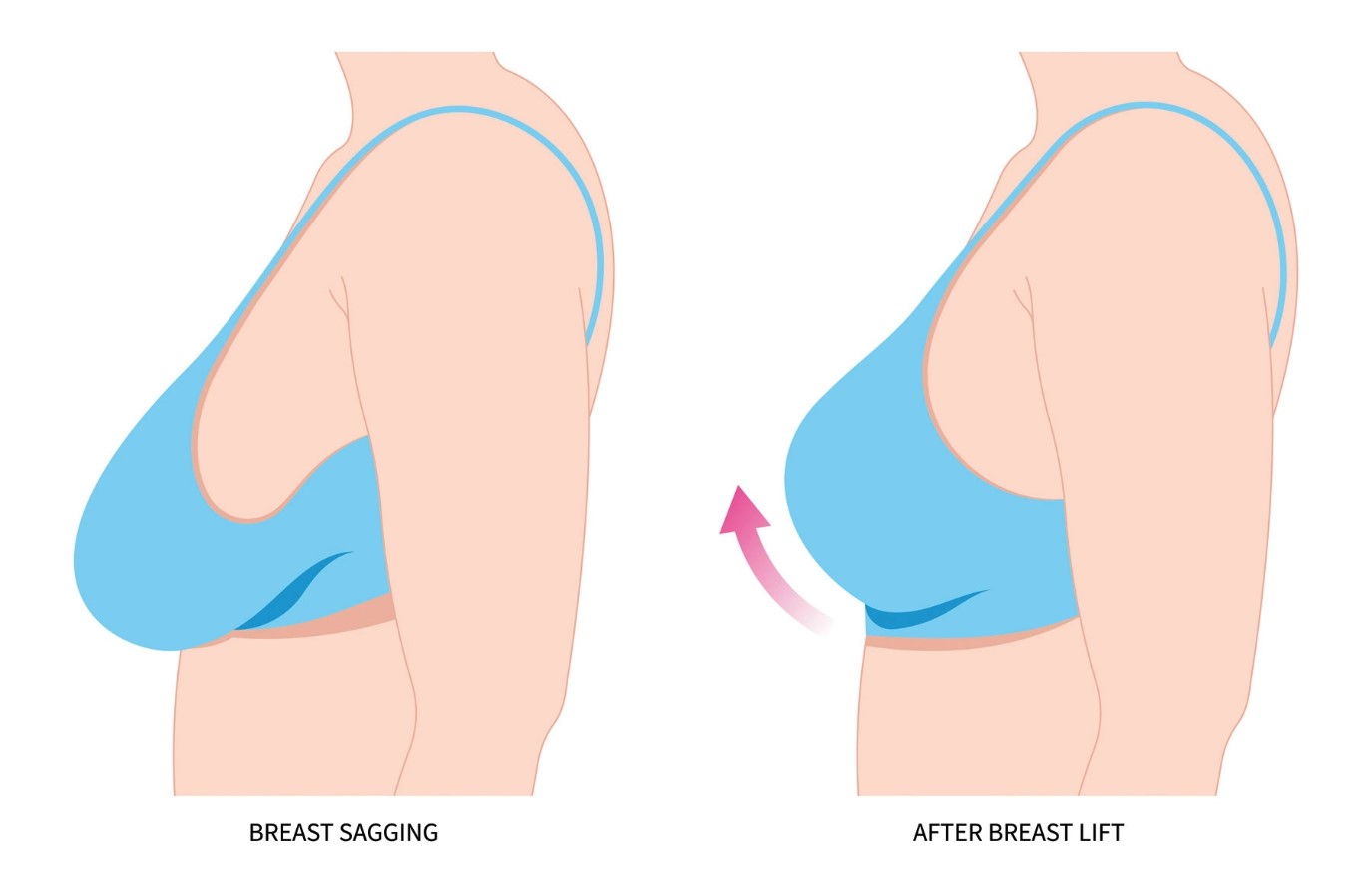What is breast lift surgery?
A breast lift, also called mastopexy, is surgery to change the shape and appearance of your breasts. During mastopexy, a plastic surgeon can:
- Lift your breast higher on your chest.
- Make your breasts more symmetrical or identical to each other.
- Reduce the size of your areola (darkened area around the nipple) and make it face forward rather than downward.
- Remove extra skin that may have stretched over time.
- Reshape your breast to a more rounded appearance.
- Tighten your breast tissue to better support your nipples and areolas.
Why Iran for Breast Lift?
Iran receives increasingly more medical tourists as a result of the best facilitation offered to the patients, well-equipped hospitals and clinics, and distinctive surgeons. It is a pioneer country at medical service in the region, and one of the most advanced countries in plastic surgery. Their surgeons perform ten thousands of operations for Iranians and other patients from all around the world.
How much does it cost?
The cost of a breast lift surgery in Iran is a small sum of its cost in other countries. It may range between $2,000 and $3,000 according to the city, hospital, and surgeon. This is while the cost of the same procedure in USA may vary between $9,000 and $16,000.
Why it’s done
Breasts change with age. They often lose firmness. And they become less elastic, which means the skin doesn’t snap back into place after being stretched. There are many causes for these kinds of breast changes, including:
- Pregnancy. During pregnancy, the bands of tissue that support the breasts (ligaments) might stretch. This happens as the breasts get fuller and heavier. The stretching might cause sagging breasts after pregnancy. This may happen whether or not you breastfeed your baby.
- Weight changes. Changes in weight can cause the breast skin to stretch. It also can cause breast skin to become less elastic.
- Gravity. Over time, gravity causes ligaments in the breasts to stretch and sag.
A breast lift can reduce sagging and raise the position of the nipples. The surgery can also lift the darker areas surrounding the nipples (areolae). The size of the areolae may be made smaller to keep them in proportion to the newly shaped breasts.
You might consider a breast lift if:
- Your breasts sag — they’ve lost shape and volume, or they’ve gotten flatter and longer
- Your nipples fall below your breast creases when your breasts aren’t supported
- Your nipples and areolae point downward
- Your areolae have stretched out of proportion to your breasts
- One of your breasts falls lower than the other
A breast lift isn’t for everyone. If you plan to become pregnant in the future, you might delay getting a breast lift. Your breasts could stretch during pregnancy and offset the results of the breast lift.
Breastfeeding may be another reason to delay a breast lift. Although breastfeeding is usually possible after the procedure, it may be harder to produce enough milk.
While a breast lift can be done on breasts of any size, those with smaller breasts will likely have longer lasting results. Larger breasts are heavier, which makes them more likely to sag again.
Why do people get breast lift surgery?
As we age, our breasts change. They may lose elasticity, causing your breasts to stretch, sag or droop. Causes include:
- Aging.
- Breastfeeding (chestfeeding).
- Genetics, or sagging breasts “run in the family.”
- Gravity.
- Pregnancy.
- Significant weight loss.
Mastopexy can make your breasts look firmer and more youthful. A breast lift can also correct perceived imperfections, such as:
- Areolas that face downward.
- Nipples that point in different directions.
- Uneven or asymmetrical breasts.
Will a breast lift procedure change the size of my breasts?
A breast lift alone won’t change the size of your breasts. But the procedure is often combined with other surgeries to make them larger or smaller. If you want to increase breast size, consider breast augmentation (implants). For smaller breasts, consider breast reduction.
Procedure Details
Breast lift, or mastopexy, can lift and tighten the breasts, and correct certain perceived imperfections.
What happens before breast lift surgery?
Before you have mastopexy, you’ll meet with a plastic surgeon. You and the surgeon will discuss:
- Your goals.
- Your medical history, including health conditions, allergies, previous surgeries and mammogram results.
- Whether you or anyone in your family has a history of breast cancer.
- Any medications you’re taking, including blood thinners, vitamins and over-the-counter drugs.
- Use of alcohol, tobacco or recreational drugs.
Your surgeon will also:
- Examine and measure your breasts.
- Draw on the area with a marker or pen.
- Take pictures of your breasts.
- Review your options for mastopexy and make recommendations.
- Talk about anesthesia to control pain and discuss the risks of surgery.
If you’re a good candidate for a breast lift and decide to move forward, your surgeon’s team will ask you to sign a consent form. By signing it, you give permission to your surgeon to perform the procedure. You also agree that you understand the risks of the procedure and have realistic expectations.
Before surgery, your plastic surgeon may ask you to:
- Get blood work or have a physical exam with your primary care provider.
- Have a mammogram.
- Stop smoking and using tobacco products.
- Stop taking certain medications (for example, aspirin, NSAIDs and herbal supplements).
What happens during mastopexy?
Most breast lifts take place in a surgical center or hospital. The procedure usually lasts an hour or two, depending on how much work is being done.
The surgical team will:
- Give you a hospital gown to wear.
- Position you on a surgical table.
- Administer anesthesia to control pain.
- Clean and prep your skin in the surgical area.
- Mark your skin with a pen or marker.
- Make incisions (cuts) around your areolas and possibly downward or outward from there.
- Cut, reposition or shape tissue and excess fat to create the look you want.
- Lift and tighten muscles by sewing them.
- Move your areola and nipple higher.
- Trim away extra skin, tissue or muscle as needed.
- Close any incisions when the procedure is complete.
- Apply bandages and possibly a surgical bra to support your breasts as they heal.
What does a breast lift incision look like?
Your surgeon will recommend the type of incision for you based on:
- Breast size and shape.
- How elastic or stretched your skin is, and how much extra skin you have.
- How much your breasts sag.
- Areola size and placement.
Incision types include:
- Crescent: This incision is a half-circle along the top half of your areola. It’s usually only used for breast augmentation in women who have little sagging.
- Donut: This common incision circles your entire areola.
- Vertical or lollipop lift: This incision goes in a circle around the entire areola, then vertically down from your areola to your breast crease. This is another common incision type.
- Inverted T or anchor: This incision circles your areola, then goes vertically down to your breast crease, then horizontally along your breast crease. It’s often used in people with more sagging or who are also having breast reduction.
What do breast lift scars look like?
Breast lift scars depend on the type of incision your surgeon used. Almost all mastopexy scars are hidden in the:
- Borders of your areolas.
- Breast crease.
- Natural contours of your breasts.
Yet you may see some scars on the surface of your breast. They’re permanent but fade a lot over time.
What happens after breast lift surgery?
Most people who have mastopexy go home the same day. You should have someone drive you home and stay with you the first night.
You may have a thin tube near one or more incisions to drain fluid and prevent swelling.
Your surgical team will give you recovery instructions. They may include:
- Caring for the drains and changing the bandages.
- Moving carefully. They may ask that you not bring your arms above your head. Keeping your elbows by your sides will allow you to perform you activities of daily living with minimal discomfort.
- Reporting any complications.
- Sleeping on your back.
- Using medications (for example, ointments or pills) to control pain or prevent infection.
- Wearing a special bra to reduce swelling and support your breasts as they heal.
Risks / Benefits
What are the advantages of mastopexy?
You will see the results of a breast lift immediately. Your breasts will look firmer, perkier and younger. Many people also report that their bras and clothes fit better.
What are the risks or complications of a breast lift procedure?
A breast lift is a surgical procedure, so it comes with risks and possible complications, including:
- Breast asymmetry (they don’t look the same).
- Bleeding or blood clots.
- Changes in sensation, like numbness of your breast skin, nipples or areolas. In addition, the left and right nipples and areolas may feel different.
- Complications from anesthesia, like nausea, vomiting or trouble waking up.
- Damage to nerves, blood vessels, muscles or organs.
- Hematoma (a pocket of blood under your skin), which may have to be drained.
- Inability to lactate (breastfeed) in the future.
- Incisions that don’t heal properly.
- Infection.
- Loss of nipple or areola.
- Pain or swelling that lasts longer than expected.
- Problems with your heart or lungs.
- Results you don’t like, which could require follow-up surgery.
- Scarring, rippling or discoloration of the skin.
- Skin irregularities and discoloration.
Recovery and Outlook
What is breast lift recovery like?
After a breast lift, you’ll have some discomfort, swelling and bruising. Your skin may feel tight. These effects get better over time and last about two weeks.
If you had drains near the incisions, your healthcare team will remove them a few days after the procedure. Incisions may take several months to heal fully. Some surgeons prefer you to sleep on your back for a few weeks. Check with your surgeon about this.
When can I go back to work and other activities?
Your surgical team will give you personalized instructions based on your surgery and recovery. Many women go back to desk work and gentle activities such as walking about a week afterward.
You may not be cleared for vigorous activities, such as lifting things, exercising and having sex, for up to six weeks.
Usually, women can wear a regular bra about eight weeks after surgery.
How long will the results of a breast lift last?
The results of a breast list should last for several years. But your breasts will still experience the normal effects of aging over time. Pregnancy and weight changes may affect the results of mastopexy.





























